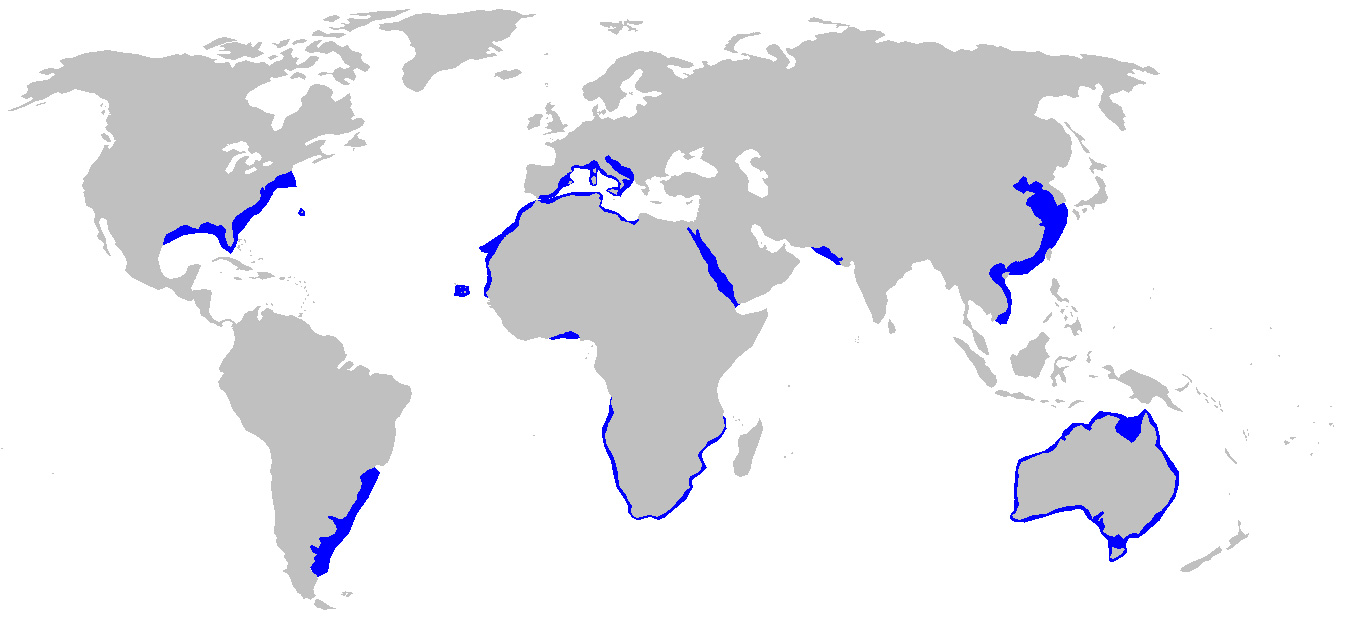
Weights and measures
| Length | 3,5 m |
|---|---|
| Weight | from 90 to 160 kg |
Animal description
The Sand Tiger Shark (Carcharias taurus), also known as the grey nurse shark in Australia and the spotted ragged-tooth shark in Africa, is a species of shark that inhabits subtropical and temperate waters worldwide. This species is easily recognizable by its bulky body, conical snout, and a unique set of protruding, needle-like teeth that give it a ferocious appearance. Despite their formidable look, sand tiger sharks are generally placid and slow-moving, posing little to no threat to humans unless provoked.Adult sand tiger sharks can reach lengths of up to 3.2 meters (10.5 feet) and weigh as much as 159 kilograms (350 pounds), although females tend to be larger than males. Their bodies are covered in a pattern of dark spots and stripes against a brownish-grey background, which helps them blend into the sandy ocean floors and rocky reefs they prefer to inhabit.
One of the most fascinating aspects of the sand tiger shark is its reproductive behavior. Unlike most sharks, which lay eggs or give live birth, the sand tiger shark practices intrauterine cannibalism. This means that the strongest embryo in the uterus will consume its siblings for nourishment, ensuring only the strongest offspring survives. This unique form of reproduction leads to the birth of one or two relatively large and well-developed pups.
Sand tiger sharks are nocturnal hunters, using their buoyant bodies to silently glide through the water and ambush prey. Their diet consists mainly of small fish, squid, crustaceans, and occasionally smaller sharks. Despite their slow appearance, they are capable of quick bursts of speed when attacking prey.
These sharks are found in coastal regions around the world, from the Atlantic Ocean to the Indian and Pacific Oceans. They prefer to stay near the ocean floor, at depths ranging from the shoreline to 191 meters (627 feet), although they are occasionally spotted near the surface.
Sand tiger sharks play a vital role in maintaining the health of marine ecosystems by controlling the population of the species they prey upon. However, they are currently listed as Vulnerable by the International Union for Conservation of Nature (IUCN) due to overfishing, habitat loss, and the slow rate at which they reproduce. Efforts are being made worldwide to protect these sharks, including fishing restrictions and the establishment of protected marine areas.
Despite their menacing appearance, sand tiger sharks are among the ocean's most misunderstood inhabitants. They are an essential part of the marine environment, contributing to the balance of marine ecosystems. With ongoing conservation efforts, it is hoped that the populations of these remarkable sharks will stabilize and continue to thrive in the world's oceans.
Map of occurrence

New photos of animals
Top 10 animals
- Dolphin gull (Leucophaeus scoresbii)
- Diana monkey (Cercopithecus diana)
- Moustached guenon (Cercopithecus cephus)
- Galápagos tortoise (Geochelone nigra complex)
- Stone loach (Barbatula barbatula)
- Japanese macaque (Macaca fuscata)
- Greek tortoise (Testudo graeca)
- Russian tortoise (Testudo horsfieldii)
- Common flying dragon (Draco volans)
- Galápagos penguin (Spheniscus mendiculus)